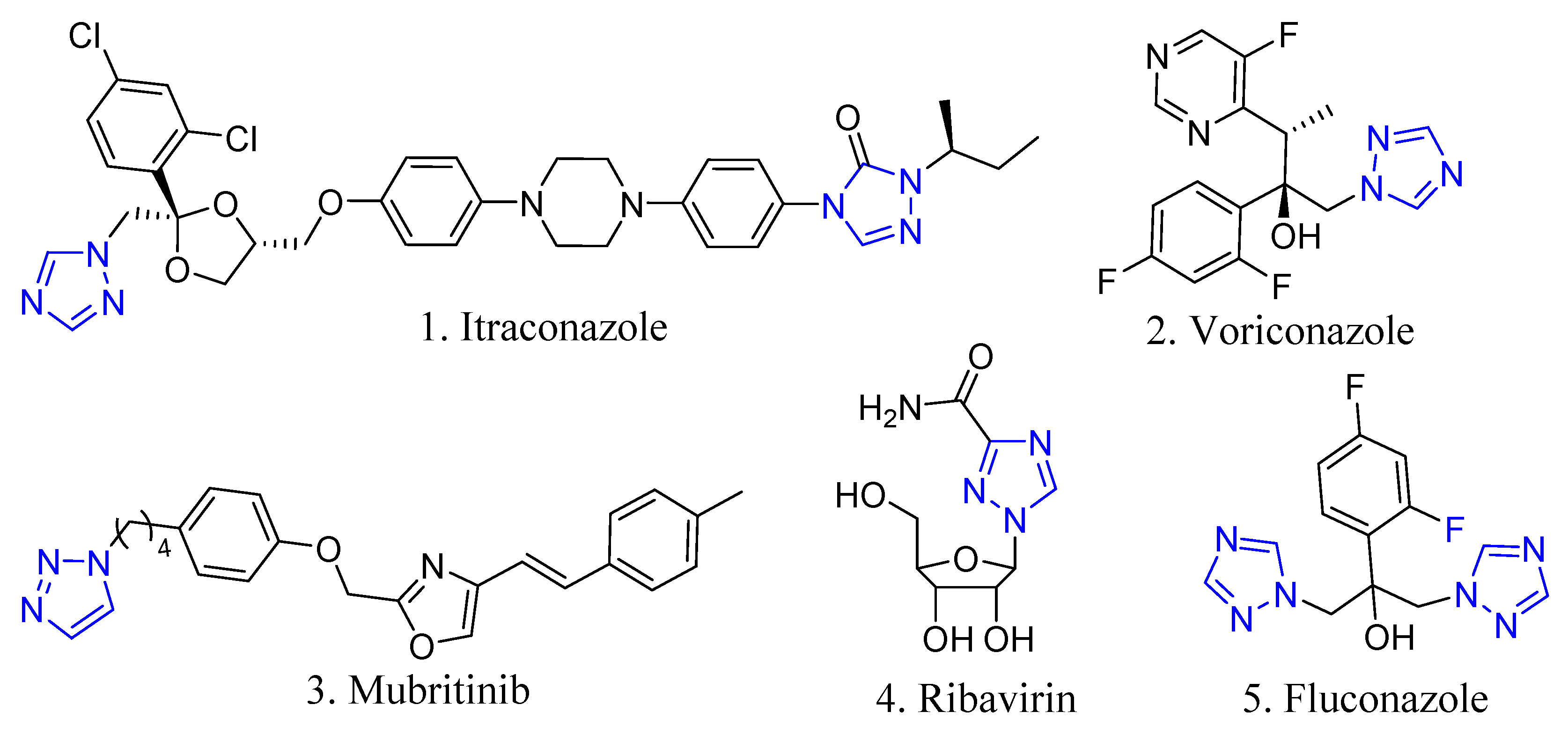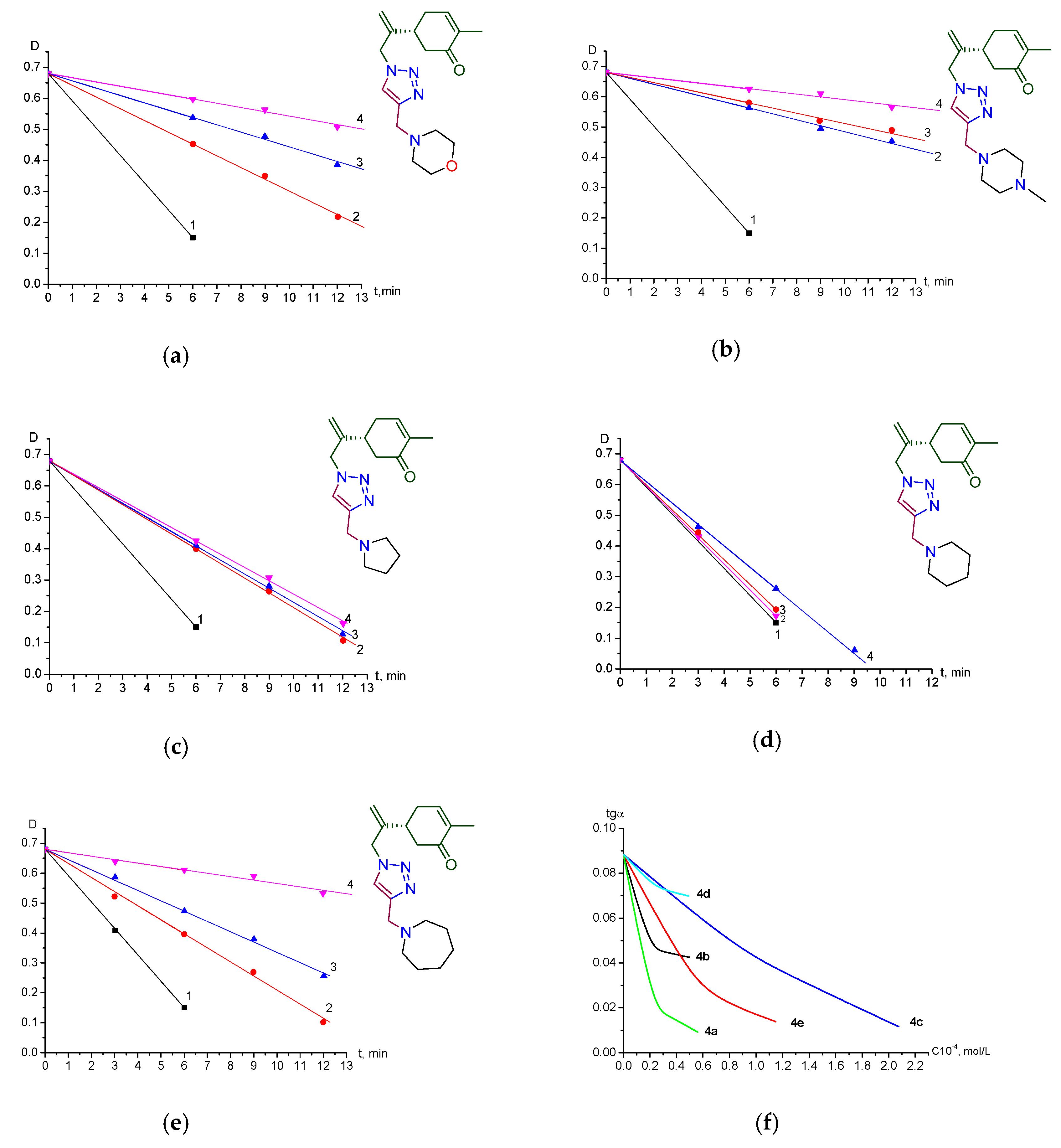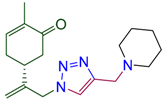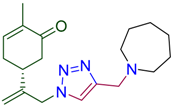Synthesis of Carvone-Derived 1,2,3-Triazoles Study of Their Antioxidant Properties and Interaction with Bovine Serum Albumin
Abstract
:1. Introduction
2. Results and Discussion
3. Materials and Methods
3.1. General Information
3.2. General Method for the Preparation of Terpenyl-1,2,3-triazoles 4a–i
4. Conclusions
Supplementary Materials
Author Contributions
Funding
Conflicts of Interest
References
- Newman, D.J.; Cragg, G.M.; Snader, K.M. The influence of natural products upon drug discovery. Nat. Prod. Rep. 2000, 17, 215–234. [Google Scholar] [CrossRef] [PubMed]
- Newman, D.J.; Cragg, G.M.; Snader, K.M. Natural products as sources of new drugs over the period 1981–2002. J. Nat. Prod. 2003, 66, 1022–1037. [Google Scholar] [CrossRef] [PubMed]
- Hill, R.A. Terpenoids. In The Chemistry of Natural Products. Chapman & Hall; Blackie Academic & Professional: New York, NY, USA, 1993. [Google Scholar]
- Zhang, L. Natural Products: Drug Discovery and Therapeutic Medicine; Humana Press: Totowa, NY, USA, 2005. [Google Scholar]
- Loza-Tavera, H. Monoterpenes in essential oils-biosynthesis and properties. Adv. Exp. Med. Biol. 1999, 464, 49–62. [Google Scholar] [PubMed]
- Little, D.B.; Croteau, R. Biochemistry of Essential Oil Plants: A Thirty-Year Overview. In Flavor Chemistry: Thirty Years of Progress; Kluwer Academic/Plenum: New York, NY, USA, 1999. [Google Scholar]
- Crowell, P.L. Prevention and therapy of cancer by dietary monoterpenes. J. Nutr. 1999, 129, 775S–778S. [Google Scholar] [CrossRef] [PubMed]
- Griffin, S.G.; Wyllie, S.G.; Markham, J.L. The role of structure and molecular properties of terpenoids in determining their antimicrobial activity. Flavour Fragr. J. 1999, 5, 322–332. [Google Scholar] [CrossRef]
- Fabian, C.J. Breast cancer chemoprevention: Beyond tamoxifen. Breast Cancer Res. 2001, 3, 99–103. [Google Scholar] [CrossRef] [PubMed]
- Oldfield, E.; Lin, F.Y. Terpene Biosynthesis: Modularity Rules. Angew. Chem. Int. Ed. 2012, 51, 1124–1137. [Google Scholar] [CrossRef] [PubMed]
- González-Burgos, E.; Gómez-Serranillos, M.P. Terpene Compounds in Nature: A Review of Their Potential Antioxidant Activity. Curr. Med. Chem. 2012, 19, 5319–5341. [Google Scholar] [CrossRef] [PubMed]
- Wattenberg, L.W.; Sparnins, V.L.; Barany, G. Inhibition of N-nitrosodiethylamine carcinogenesis in mice by naturally occurring organosulfur compounds and monoterpenes. Cancer Res. 1989, 49, 2689–2692. [Google Scholar] [PubMed]
- Crowell, P.L.; Kennan, W.S.; Vedejs, E.; Gould, M.N. Chemoprevention of limonene carcinogenesis by hydroxylated metabolites. In Proceedings of the 81st Annual Meeting of the American Association for Cancer Research, Washington, DC, USA, 23–26 May 1990. [Google Scholar]
- Mills, J.J.; Chari, R.S.; Boyer, I.J.; Gould, M.N.; Jirtle, R.L. Induction of apoptosis in liver tumors by the monoterpene perillyl alcohol. Cancer Res. 1995, 55, 979–983. [Google Scholar] [PubMed]
- Haag, J.D.; Gould, M.N. Mammary carcinoma regression induced by perillyl alcohol, a hydroxylated analog of limonene. Cancer Chemother. Pharmacol. 1994, 34, 477–483. [Google Scholar] [CrossRef] [PubMed]
- Rostovtsev, V.V.; Green, L.G.; Fokin, V.V.; Sharpless, K.B. A Stepwise Huisgen Cycloaddition Process: Copper(I)—Catalyzed Regioselective “Ligation” of Azides and Terminal Alkynes. Angew. Chem. Int. Ed. 2002, 41, 2596–2599. [Google Scholar] [CrossRef]
- Tornøe, C.W.; Christensen, C.; Meldal, M. Peptidotriazoles on Solid Phase: [1,2,3]-Triazoles by Regiospecific Copper(I)-Catalyzed 1,3-Dipolar Cycloadditions of Terminal Alkynes to Azides. J. Org. Chem. 2002, 67, 3057–3062. [Google Scholar] [CrossRef]
- Sokolova, N.; Nenajdenko, V.G. Recent Advances in the CuI-catalyzed Alkyne-Azide Cycloaddition (CuAAC): Focus on Functionally Substituted Azides and Alkynes. RSC Adv. 2013, 3, 16212–16242. [Google Scholar] [CrossRef]
- Sokolova, N.V.; Latyshev, G.V.; Lukashev, N.V.; Nenajdenko, V.G. Design and synthesis of bile acid-peptide conjugates linked via triazole moiety. Org. Biomol. Chem. 2011, 9, 4921–4926. [Google Scholar] [CrossRef] [PubMed]
- Nenajdenko, V.G.; Gulevich, A.V.; Sokolova, N.V.; Mironov, A.V.; Balenkova, E.S. Chiral Isocyanoazides: Efficient Bifunctional Reagents for Bioconjugation. Eur. J. Org. Chem. 2010, 1445–1449. [Google Scholar] [CrossRef]
- Vasilevsky, S.F.; Govdi, A.I.; Sorokina, I.V.; Tolstikova, T.G.; Baev, D.S.; Tolstikov, G.A.; Mamatuyk, V.I.; Alabugin, I.V. Rapid Access to New Bioconjugates of Betulonic Acid via Click Chemistry. Bioorg. Med. Chem. Lett. 2011, 21, 62–65. [Google Scholar] [CrossRef] [PubMed]
- Vasilevsky, S.F.; Govdi, A.I.; Shults, E.E.; Shakirov, M.M.; Tolstikov, G.A.; Alabugin, I.V. Efficient Synthesis of the Betulonic Acid -Acetylene Hybrids and Their Hepatoprotective and Anti-Inflammatory Activity. Biorgan. Med. Chem. 2009, 17, 5164–5169. [Google Scholar] [CrossRef] [PubMed]
- Ferreira, V.F.; da Rocha, D.R.; da Silva, F.C.; Ferreira, P.G.; Boechat, N.A.; Magalhães, J.L. Novel 1H-1,2,3-, 2H-1,2,3-, 1H-1,2,4- and 4H-1,2,4-triazole derivatives: A patent review (2008–2011). Expert Opin. Ther. Pat. 2013, 23, 319–331. [Google Scholar] [CrossRef] [PubMed]
- Mandal, S.K.; Saha, D.; Jain, V.K.; Jain, B. Synthesis and antitubercular activity of some triazole derivatives of propyl gallate. Int. J. Pharm. Sci. Res. 2010, 1, 465–472. [Google Scholar]
- Tan, S.L.; Pause, A.; Shi, Y.; Sonenberg, N. Hepatitis C therapeutics: Current status and emerging strategies. Nat. Rev. Drug. Discov. 2002, 1, 867–881. [Google Scholar] [CrossRef] [PubMed]
- Prusiner, P.; Sundaralingam, M. A New Class of Synthetic Nucleoside Analogues with Broad-spectrum Antiviral Properties. Nat. New Biol. 1973, 244, 116–118. [Google Scholar] [CrossRef] [PubMed]
- Prusiner, P.; Sundaralingam, M. The crystal and molecular structures of two polymorphic crystalline forms of virazole (1-β-d-ribo furanosyl-1,2,4-triazole-3-carboxamide). A new synthetic broad sprectrum antiviral agent. Acta Cryst. Sect. B 1976, 32, 419–426. [Google Scholar] [CrossRef]
- Kushwaha, K.; Kaushik, N.; Jain, S.C. Design and synthesis of novel 2H-chromen-2-one derivatives bearing 1,2,3-triazole moiety as lead antimicrobials. Bioorg. Med. Chem. Lett. 2014, 24, 1795–1801. [Google Scholar] [CrossRef] [PubMed]
- Weinges, K.; Schwarz, G. Radikalische Cyclisierung von Dienen, VI. Substratkontrollierte asymmetrische Synthese von (3aS,6aR)-(+)-3,3a,6,6a-Tetrahydro-2H-cyclopenta[b]furan-2-on. Liebigs Ann. Chem. 1993, 1993, 811–814. [Google Scholar] [CrossRef]
- Bielski, B.H.J.; Cabelli, D.E.; Arudi, R.L.; Ross, A.B. Reactivity of HO2/O2− Radicals in Aqueous Solution. J. Phys. Chem. Ref. Data 1985, 14, 1041–1100. [Google Scholar] [CrossRef]
- Ernestova, L.S.; Semenova, I.V.; Vlasova, G.V.; Lee Wolf, N. Redox transformation of pollutants in natural waters. In Hydrological, Chemical and Biological Processes of Transformation and Transport of Contaminants in Aquatic Environments; IAHS Publisher: New York, NY, USA, 1994; Volume 219, pp. 67–74. [Google Scholar]
- Simonsen, M.E.; Muff, J.; Bennedsen, L.R.; Kowalski, K.P.; Søgaard, E.G. Photocatalytic bleaching of p-nitrosodimethylaniline and a comparison to the performance of other AOP technologies. J. Photochem. Photobiol. A Chem. 2010, 216, 244–249. [Google Scholar] [CrossRef] [Green Version]
- Urquiza, N.M.; Naso, L.G.; Manca, S.G.; Lezama, L.; Rojo, T.; Williams, P.A.M.; Ferrer, E.G. Antioxidant activity of methimazole–copper (II) bioactive species and spectroscopic investigations on the mechanism of its interaction with Bovine Serum Albumin. Polyhedron 2012, 31, 530–538. [Google Scholar] [CrossRef]
- Li, Q.; Yang, W.; Wu, L.; Qi, H.Y.; Huang, Y.; Zhang, Z. Interaction of Warfarin with Human Serum Albumin and Effect of Ferulic Acid on the Binding. J. Spectrosc. 2014. [Google Scholar] [CrossRef]
- Manjunath, D.M.; Sharanappa, T.N.; Shrinivas, D.J.; Uttam, A.M.; Shivamurti, A.C. Multi-spectroscopic investigation of the binding interaction of fosfomycin with bovine serum albumin. J. Pharm. Anal. 2015, 5, 249–255. [Google Scholar]
- Ross, D.P.; Subramanian, S. Thermodynamics of protein association reactions: Forces contributing to stability. Biochemistry 1981, 20, 3096–3102. [Google Scholar] [CrossRef] [PubMed]
- Kragh-Hansen, U. Structure and ligand binding properties of human serum albumin. Dan. Med. Bull. 1990, 37, 57–84. [Google Scholar] [PubMed]
- Lakowicz, J. Principles of Fluorescence Spectroscopy; Springer: New York, NY, USA, 2006. [Google Scholar]
Sample Availability: Samples of all the compounds 4a–i are available from the authors. |





 | |||||
|---|---|---|---|---|---|
| Entry | Solvent | Catalyst (mol%) | Time, h | Temp., °C | Isolated Yield a |
| 1. | DMSO | CuBr(10) | 5 | 65 | 39 |
| 2. | DMSO | CuI(10) | 5 | 65 | 48 |
| 3. | MeCN: DMSO—1:1 | CuI(10) | 8 | 60 | 56 |
| 4. | MeCN | CuI (10) | 8 | 60 | 69 |
| 5. | MeCN | CuI (10) | 10 | 60 | 71 |
| 6. | MeCN | CuI (5) | 10 | 60 | 78 |
| Terpenyl-1,2,3-triazoles | Yield, % | Terpenyl-1,2,3-triazoles | Yield, % | ||
|---|---|---|---|---|---|
| 4a |  | 78 | 4f |  | 65 |
| 4b |  | 79 | 4g |  | 63 |
| 4c |  | 73 | 4h |  | 84 |
| 4d |  | 79 | 4i |  | 76 |
| 4e |  | 81 |
| Tested Compound | Rate Constant HO• + 4a–e (M s−1) |
|---|---|
| 4a | 1.155 × 109 |
| 4b | 4.483 × 109 |
| 4c | 1.359 × 109 |
| 4d | 0.104 × 109 |
| 4e | 0.407 × 109 |
| Ascorbic acid (control) | 9.450 × 109 |
| T, K | Kb, M−1 | N | ΔH, kJ mol−1 | ΔG, kJ mol−1 | ΔS, J mol−1 K−1 |
|---|---|---|---|---|---|
| 298 | 2.40·× 103 | 1.001 ± 0.079 | 67.989 | −19.283 | 292.86 |
| 308 | 5.85·× 103 | 1.061 ± 0.066 | −22.212 |
| T, K | I, cm3 L × mol−1 | E | R0, nm | r, nm |
|---|---|---|---|---|
| 298 | 1.79 × 10−14 | 0.019 | 3.778 | 7.27 |
| 308 | 1.80 × 10−14 | 0.043 | 3.782 | 7.06 |
© 2018 by the authors. Licensee MDPI, Basel, Switzerland. This article is an open access article distributed under the terms and conditions of the Creative Commons Attribution (CC BY) license (http://creativecommons.org/licenses/by/4.0/).
Share and Cite
Galstyan, A.S.; Martiryan, A.I.; Grigoryan, K.R.; Ghazaryan, A.G.; Samvelyan, M.A.; Ghochikyan, T.V.; Nenajdenko, V.G. Synthesis of Carvone-Derived 1,2,3-Triazoles Study of Their Antioxidant Properties and Interaction with Bovine Serum Albumin. Molecules 2018, 23, 2991. https://doi.org/10.3390/molecules23112991
Galstyan AS, Martiryan AI, Grigoryan KR, Ghazaryan AG, Samvelyan MA, Ghochikyan TV, Nenajdenko VG. Synthesis of Carvone-Derived 1,2,3-Triazoles Study of Their Antioxidant Properties and Interaction with Bovine Serum Albumin. Molecules. 2018; 23(11):2991. https://doi.org/10.3390/molecules23112991
Chicago/Turabian StyleGalstyan, Armen S., Armen I. Martiryan, Karine R. Grigoryan, Armine G. Ghazaryan, Melanya A. Samvelyan, Tariel V. Ghochikyan, and Valentine G. Nenajdenko. 2018. "Synthesis of Carvone-Derived 1,2,3-Triazoles Study of Their Antioxidant Properties and Interaction with Bovine Serum Albumin" Molecules 23, no. 11: 2991. https://doi.org/10.3390/molecules23112991





